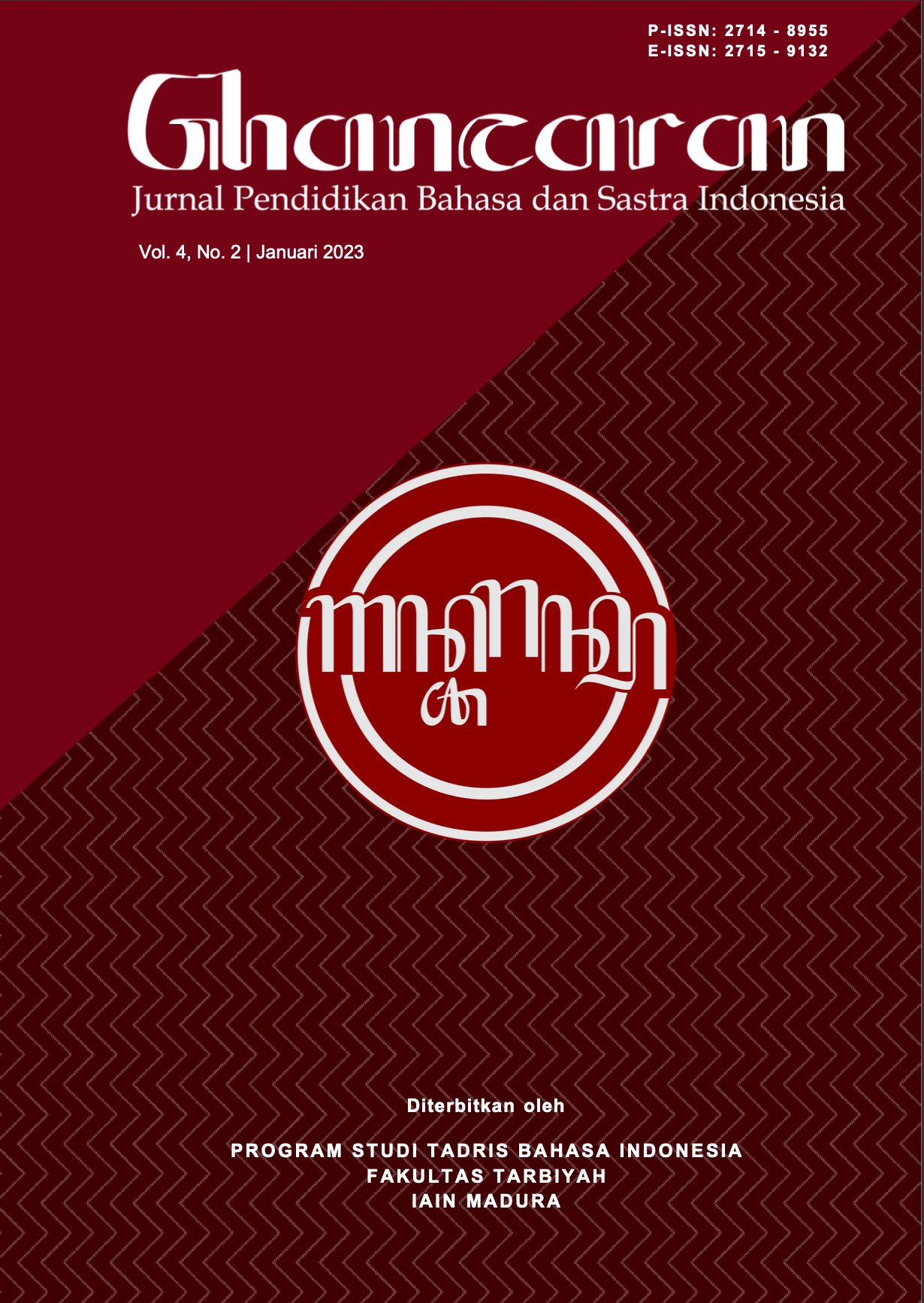Refleksi Karakter Masyarakat Madura dalam Film Pendek Mata Pena: Kajian Semiotika
 Abstract views: 754
,
Abstract views: 754
,
 PDF downloads: 974
PDF downloads: 974
Abstract
This study aims to describe the character of Madurese life contained in the film "Mata Pena" with a semiotic approach. The urgency of this research is to base the view that the Madurese are notlike the negative views that have been thought so far. This study uses a qualitative approach with a description technique. The data collection technique used is the technique of watching videos, noting important things, and literature as a reinforcing reference to the argument. The analysis technique used is to reduce the data according to its classification, display the data, and conclude. This study is related to the reflection of the character of the Madurese community in the film. This study uses a qualitative approach with a description technique. The data collection technique used is the technique of watching videos, noting important things, and literature as a reinforcing reference to the argument. The analysis technique used is to reduce the data according to its classification, display the data, and conclude. The results of this study are (1) The aspects of the sign are grouped in the form of denotation, connotation, and myth. In simple terms, the meaning of denotation is the depiction of the true meaning of the Madurese language into Indonesian. For the meaning of connotation and myth are two things related to the agreed meaning in the cultural life of the Madurese community. This is illustrated in the myth that contains the proverb (parebhasan) of Madura which is mutually agreed upon. (2) The reflection (character) in the short film Madura contains several characters, namely kinship, firm (steadfast), careful, and trustworthy. These characters are the implementation of Madurese culture in daily social life.
Downloads
References
Alfian. (2015). Analisis Semiotika Papan Reklame Kampanye Politik Calon Legislatif DPRD Tahun 2014 Dapil I (Tanete Riattang Barat, Tanete Riattang, Tanete Skripsi). Skripsi.
Azhar, I. N. (2009). Karakter Masyarakat Madura dalam Syair-Syair. 12(02), 217–227.
Barthes, R. (2006). Mitologi. Penerjemah Nurhadi dan A. Sihabul Millah. Yogyakarta: Kreasi Wacana.
________.2017. Elemen-Elemen Semiologi. Cetakan Pertama. Penerjemah M. Ardiansyah. Yogyakarta: Basabasi.
Danesi, Marcel. 2012. Pesan, Tanda, dan Makna: Buku Teks Dasar Mengenai Semiotika dan Teori Komunikasi. Penerjemah Evi Setyarini dan Lusi Lian Piantari. Yogyakarta: Jalasutra.
Efawati, R. (2018). Karakteristik Budaya Madura dalam Humor. Al Iman: Jurnal Keislaman dan Kemasyarakatan, 2(1), 83-93.
Efendi, A. N., Jannah, R. & Rahmawati, F. (2021). Tanean Lanjhang: a Reflection of Guyub and Ukhuwah Strengthening of Ukhuwah Among Madurese Society. Islamuna: Studi Islam, 8(2), 106–123.
Effendy, M. H. (2011). Tinjauan Deskriptif Tentang Varian Bahasa Dialek Pamekasan. Okara, 1(6), 64–74.
Hidayat, A. (2002). Karakter Orang Madura dan Falsafah Politik Lokal.
Hipni, M., & Karim, M. (2019). Akar Budaya Emansipasi Pekerja Imigran Wanita Madura; Kajian Terhadap Praktik Waris Adat Madura. KABILAH : Journal of Social Community, 4(2), 1–15.
Ibrahim. (2015). Metodologi Penelitian Kualitatif: Panduan Penelitian Beserta Contoh Proposal Kualitatif. Perpustakaan Nasional: Pontianak.
Mudjiono, Y. (2011). Kajian Semiotika dalam Film. Jurnal Ilmu Komunikasi, 1(1), 125–138.
Mukminin, A., & Busri, H. (2021). Representasi Kearifan Lokal Masyarakat Madura dalam Metafora pada Lagu-Lagu Daerah Madura. Jurnal Sastra Indonesia, 10(3), 179-190.
Muthmainnah. (1998). Jembatan Suramadu: Respon Ulama Terhadap Industrialisasi. Yogyakarta: LKPSM.
Naimah, N., Mubayyamah, M., & Efendi, A. N. (2021). Ekspresi Kultural Masyarakat Madura dalam Cerpen Sketsa Sebilah Celurit Karya Suhairi. GHANCARAN: Jurnal Pendidikan Bahasa dan Sastra Indonesia, 2(2), 141–150.
Nugraha, A. P. (2017). Makna Peribahasa Madura dan Stereotip Kekerasan pada Etnis Madura (Tinjauan Stilistika). LiNGUA, 12(2).
Nazaruddin, Kahfie. (2015). Pengantar Semiotika. Yogyakarta: Graha Ilmu.
Rifai, Mien Ahmad. (2007). Manusia Madura: Pembawaan, Perilaku, Etos Kerja, Penampilan, dan Pandangan Hidupnya seperti Dicitrakan Peribahasanya. Yogyakarta: Nuansa Aksara.
Sobur, Alex. (2013). Semiotika Komunikasi. Bandung: Remaja Rosdakarya
Utsman, H. (2020). TENGKA: Etika Sosial dalam Masyarakat Tradisional Madura. Yogyakarta: Sulur Pustaka.
Vera, Nawiroh. (2015). Semiotika dalam Riset Komunikasi, Cet 2. Bogor: Ghalia Indonesia.
Wahyudi, Muhtar, dkk. (2015). Madura: Masyarakat, Budaya, Media, dan Politik. Puskakom Publik Bekerjasama dengan Penerbit Elmatera.
Copyright (c) 2023 GHANCARAN: Jurnal Pendidikan Bahasa dan Sastra Indonesia

This work is licensed under a Creative Commons Attribution-ShareAlike 4.0 International License.
Ghancaran: Jurnal Pendidikan Bahasa dan Sastra Indonesia uses an Open Access Policy under the Creative Commons Attribution-ShareAlike 4.0 International License. Authors publishing in this journal agree to the following terms:
- Ghancaran Journal holds the copyright and grants the journal rights for first publication with the work simultaneously licensed under a

The work is distributed under Creative Commons Attribution-ShareAlike 4.0 International License which allows others to share, copy, and redistribute the material in any media or format and adapt, remix, change, and develop the material even for commercial purposes, as long as it is stated credit and license derivative works under similar terms. - Authors may make additional contractual arrangements for non-exclusive distribution of the journal's published work version.
- Authors are permitted to post their work online (e.g., in institutional repositories or on their websites) before and during submission, as doing so may lead to productive exchange.



















